
The Nokia 6230 is a mobile phone based on the Nokia Series 40 platform. It was announced on 28 October 2003 and released in February 2004.
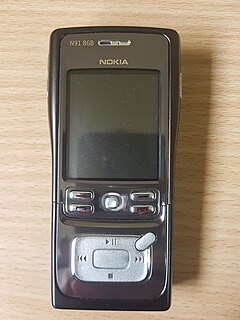
The Nokia N91 is a smartphone produced by Nokia as part of their Nseries line of portable devices. It was announced on April 27, 2005 along with N70 and N90 as the first three Nseries devices. The N91 ran on Symbian-based S60 3rd Edition. It was the first ever phone encompassing a 4 GB internal hard drive, allowing storage for 3,000 songs. The N91 is highly focused on music,. with dedicated music keys on the front which slide down to reveal the keypad. It also featured the industry-standard 3.5 mm headphone jack, and was anticipated as a major challenger to Apple, whose iPod dominated the industry. The design of the N91 is based on stainless steel with a matte finish.

The Sony Ericsson K750, introduced in June 2005, was a high-end mobile phone, the successor to the now discontinued K700, and which was succeeded by the K800i in Q2 2006.

The Samsung SGH-D600i is a mobile phone. It is usable as:
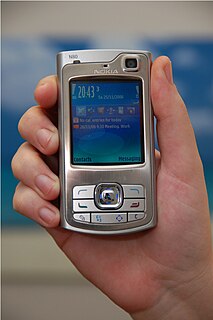
The Nokia N80 is a 3G smartphone from Nokia announced on November 2, 2005, part of the multimedia Nseries line. It runs on Symbian OS v9.1 and the S60 3rd Edition interface. It was first released in June 2006.

The Sony Ericsson K800i, and its variant, the Sony Ericsson K790, are mobile phone handsets manufactured by Sony Ericsson. Launched in July 2006, the phones are the successor to the Sony Ericsson K750i. Both of the phones feature a 3.2-megapixel digital camera complete with a xenon flash, a protective lens cover, and a new "BestPic" bracketing feature, and are the first to be tagged with the Sony Cyber-shot branding. The new "BestPic" feature takes 9 full quality snapshots of a subject in quick succession, allowing the user to choose the best shots from them. On the entertainment front, the phones have a media player supporting MP3, AAC/AAC+/eAAC+ and WMA music files and 3GP/MPEG-4 video files. The phones also feature a RDS FM radio, and a Memory Stick Micro (M2) slot for expandable solid state memory. The K790/K800 models are also the first Sony Ericsson mobile phones to use ATI's Imageon 2192 graphics engine, which delivers a full 3D gaming graphics for Java and full support for its 3.2-megapixel camera. It is the phone used by James Bond in the 2006 Casino Royale film and trailers.

The Nokia 3250 is a smartphone running Symbian OS v9.1, announced on September 26, 2005. It features a unique 'twist' design that transforms the traditional phone keypad into a camera and dedicated music control keys. It was marketed as a music phone and can store up to 2 gigabytes of music and other data thanks to a microSD memory card slot, and features a two-megapixel camera as well as other smartphone capabilities.

The Nokia 6233 phone made by Nokia is the successor to the Nokia 6230i. It is a 3G/GSM/WCDMA mobile phone that runs the Series 40 3rd Edition, Feature Pack 1 UI on the Nokia operating system.

The Nokia N95 is a smartphone produced by Nokia as part of their Nseries line of portable devices. Announced in September 2006, it was released to the market in March 2007. The N95 ran S60 3rd Edition, on Symbian OS v9.2. It has a two-way sliding mechanism, which can be used to access either media playback buttons or a numeric keypad. It was first released in silver and later on in black, with limited edition quantities in gold and purple. The launch price of the N95 was around €550.

The Nokia N73 is a smartphone announced by Nokia on 2006 & Music Edition 2007, as part of the Nseries and started shipping on 15 July. The N73 succeeded the N70 and packed in numerous multimedia features. It features a 3.2 megapixel autofocus camera, a front camera, a then-large 2.4-inch display, and stereo speakers, all in a relatively slim and pocketable size and form. It runs on Symbian v9.1.
The Motorola Slvr is a series of mobile phones from Motorola, and is one of the series in the 4LTR line. The first phones were released in early 2005. They are designed to be very thin and lightweight.
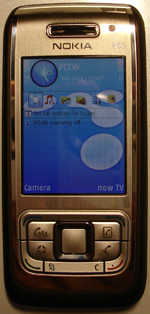
The Nokia E65 is a smartphone in the Eseries range, a S60 platform third edition device with slide action. It shared many of the features of the N95 released around the same time, but thinner, lighter and without the GPS. It was followed fairly quickly by the E66, which was very similar but gained an FM radio, a newer release of S60, A2DP bluetooth, GPS and 3.2 mpixel camera.

The Nokia 6120 classic is a mid-range smartphone from Nokia that was announced on 17 April 2007. It runs on Symbian v9.2 with a S60 3rd Edition FP1 user interface.
The Nokia 6000 series or Classic Business series is range of mobile phones marketed by Nokia. This family of phones is notable for their conservative, unisex designs, making the family popular with business users.
The Nokia 3600 slide is a mobile phone by Nokia that was released in August 2008. The phone runs the Series 40 3rd Edition platform. This is classed as the 'low end version' of the Nokia 6600 slide, its major difference being the lack of 3G support.

The Nokia E71 is a smartphone introduced in May 2008 from the Eseries range with a QWERTY keyboard targeting business users worldwide. It runs on Symbian OS v9.2, with a Series 60 3rd Edition, second generation Feature Pack 1. The Nokia E71 succeeded the Nokia E61/61i models, building on the base design and form factor but enhancing on the feature set.

The Sony Ericsson C905 is a high-end mobile phone in Sony's 'C' (Cyber-shot) range, which, along with the low-end 'S' (Snapshot) range cameras, supplants the earlier 'K' range of camera phones. It is the flagship model in Sony Ericsson's range for 2008 and it was released on 22 October 2008. It's the first 8-megapixel camera phone to be released outside Korea, while adding the Assisted GPS (A-GPS) and Wi-Fi function. It is also the first Sony Ericsson mobile phone to support the DLNA sharing network and is the first Cyber-shot phone to also be released for AT&T.
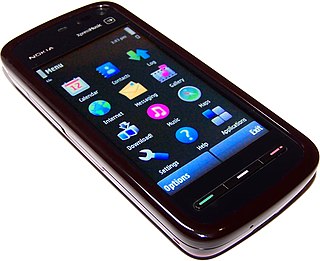
Nokia 5800 XpressMusic is a smartphone part of the XpressMusic line, announced by Nokia on 2 October 2008 in London and started shipping in November of that year. Code-named "Tube", it was the first touchscreen-equipped S60 device by Nokia - essentially it was the first device to run Symbian^1, also known as S60 5th Edition, the touch-specific S60-based platform created by the Symbian Foundation. The touchscreen features tactile feedback.
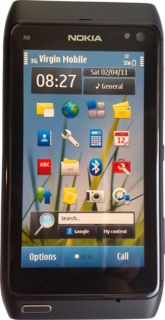
The Nokia N8 is a touchscreen-based smartphone developed by Nokia. Announced on 27 April 2010, the Nokia N8 was the first device to run on the Symbian^3 mobile operating system and it was the company's flagship device for the year. It was released on 30 September 2010 at the Nokia Online Store before being released in markets around the world on 1 October 2010. There were two version made, the N8 and the N8-00. The N8 was made for Vodafone and locked to its networks, and the N8-00 was made by Microsoft and open network.




















